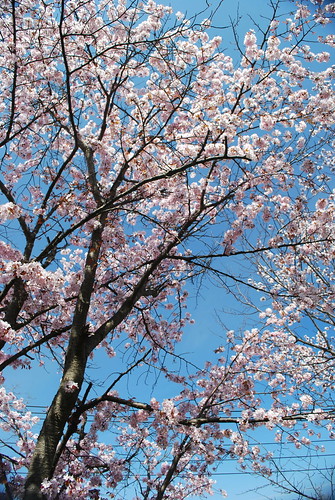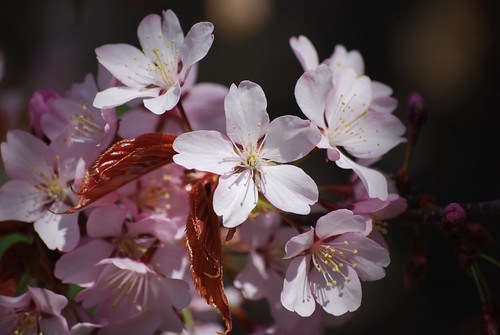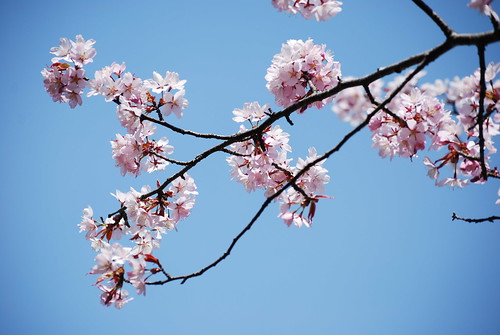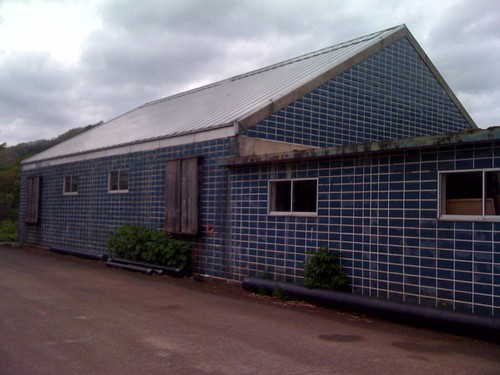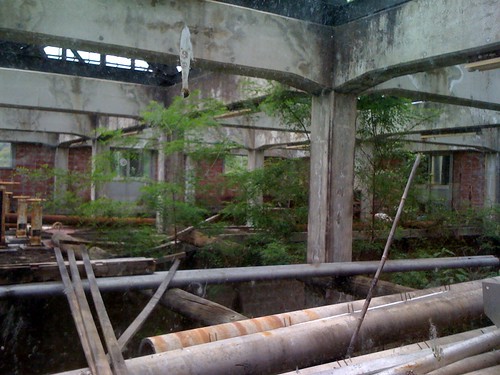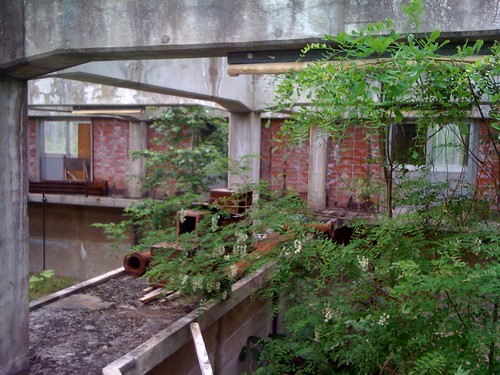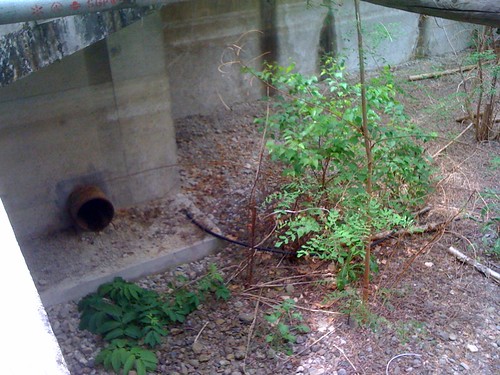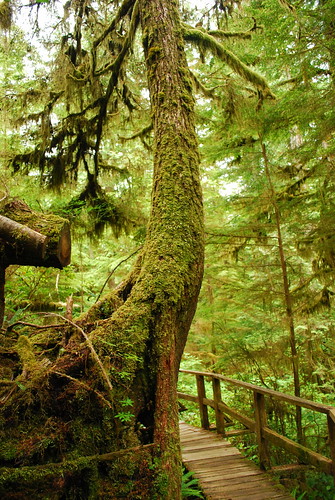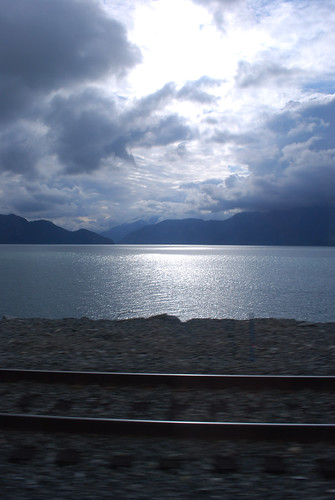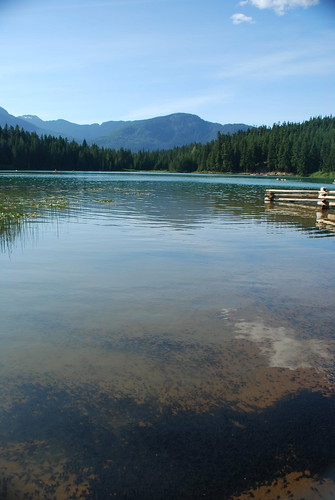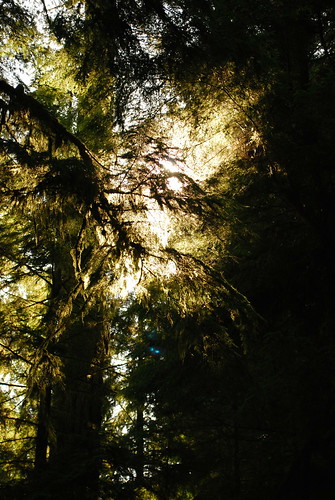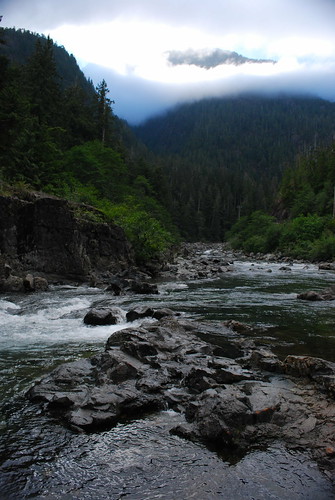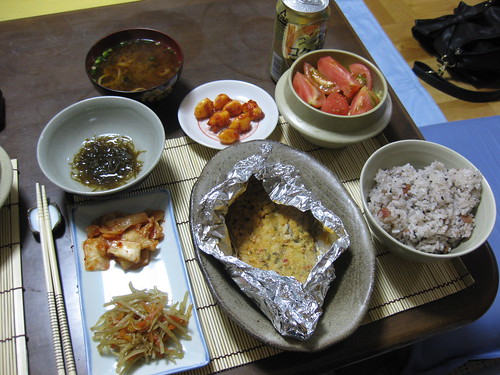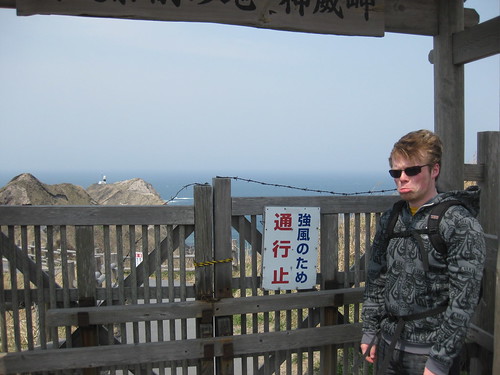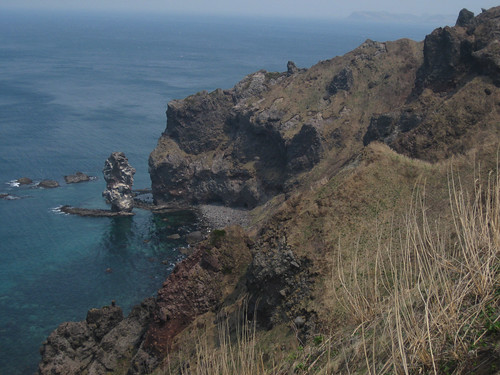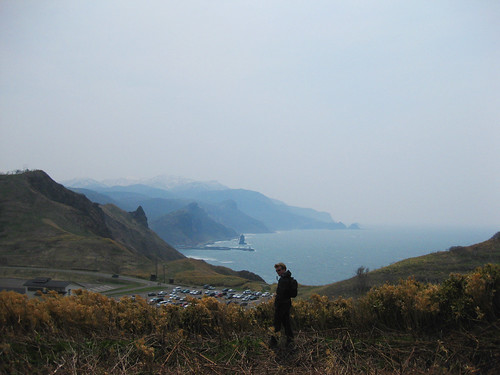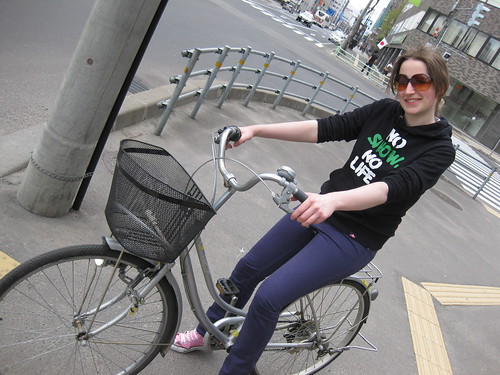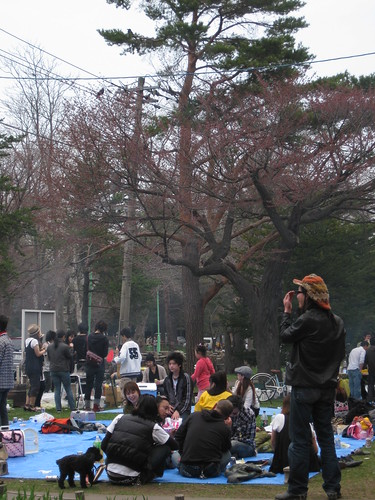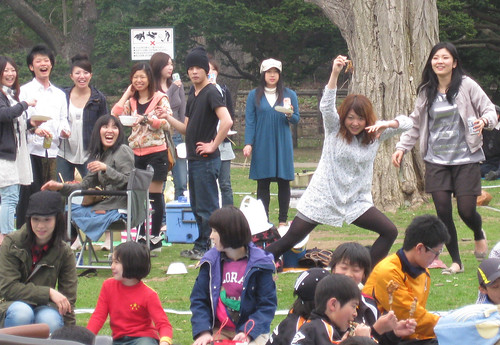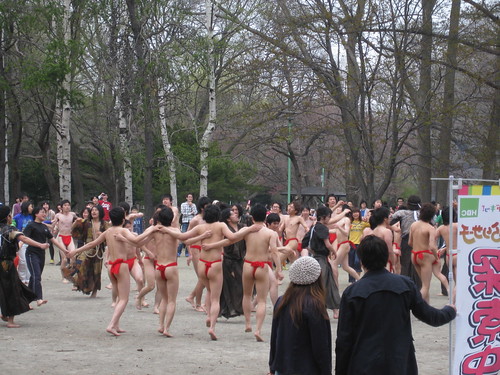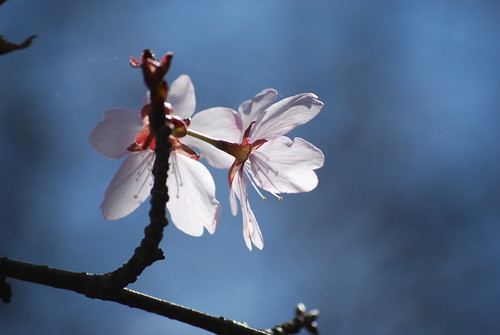 Sometimes I talk too much.
Sometimes I talk too much.Tuesday, May 25, 2010
Sakura Saturdays
 Sometimes I talk too much.
Sometimes I talk too much.Monday, May 24, 2010
Victoria Day on Sapporo Dake
Some friends and I spent our Victoria Day weekend in a cabin with beer. Completely as it should be.
The cabin was in Japan, which was a little unorthodox for Victoria Day, and I only brought two cans of beer instead of the usual 24 as I didn’t feel like dragging copious amounts of booze half way up a mountain. Also, there were a large number of Russians, which is definitely a new addition.
But the core elements were still there: Friends, Cabins, Beer.
Heather had tracked down a hike run by our buddy Leon over at Hokkaido Adventures (who we last saw when he helped us brave an icy hurricane back in February). It was a two-day climb of Sapporo Dake with the Saturday night spent in a mountain cabin.
The hike up to the cabin was the very image of late spring. Leon had appointed me to walk at the head of our group. He’d instructed me to break any time we came to a river crossing as even this late in the season the river could still be frozen over, and he wanted to check the crossings before we attempted them. However, crossing after crossing was completely free of any signs of winter, save the rushing water of its end. The downward regions of the mountain were as if out of a fairy tale, with green, flowery growth off in the woods and the path itself sporting unbroken runners of green clovery leaves to frame the well-trodden brown. There were shaded rooms of ranked tree columns and ghibli-esque rocky rapids. There was the soft forest carpets, and there was the sucking mud. Despite Leon’s advice before the hike to be ready for snow, We didn’t reach any until late in the day on Saturday, just below the cabin. And, as if it were sitting right on some icy terminator line, it was only beyond the cabin that the river was still iced and snowed over.
The cabin itself was a rather ridiculously magical place. The downstairs was all yellow lantern light, warm woodsmoke, and the sentient, lazy clouds puffing out of the hookah. Heather commented on how that downstairs rang with a babel of voices, describing
“the wonder of being in a room with people who spoke English, French, Spanish, Arabic, Russian, Japanese, Cantonese and Korean. The feeling of having my London back – of Russian Koreans and Australian Russians talking Japanese and smoking shisha, whilst a Columbian taught a Californian how to salsa dance, and people from five different countries played snap together, over a discussion of halal meat, and with the background of a half-Maori talking about losing a language, and its politically expedient reclamation, half way around the world.”
The upstairs was two elevated rows of tatami mats under the exposed wooden rafters, our large camping packs standing at the heads of our bedrolls and sleeping bags like mountainous claim stakes. There was the toilet: a standard eastern squat number with one of the longest drops I’d ever seen: the used toilet paper disposed of in an artfully Japanese way involving individual origami waste boxes folded out of flyers. Our running water was also our refrigerator: an icy mountain stream channeled thorough a pipe into a small collecting pool. Its one end was a flotilla of beer cans and booze bottles, and the other the source from which we filtered and ladled our drinking and cooking water. At the cabin’s center was a large metal woodstove, and we’d remove circular pieces of it that resembled fiery manhole covers to nest the colossal cast iron kettle used for boiling water directly over the fires below. It was from this woodstove that Leon fed us rice and curry and raamen, and the heat he didn’t use would drift up into the sleeping floor through the almost decorative latticework of wood that was the vent in the ceiling. And when I lazily (and full-ly, and somewhat drunkenly) fell asleep on Saturday night, it was to the smell of this woodsmoke up in the rafters and the sound of the river’s neverending rush as it broke around the island on which the cabin stood.
Sunday was as glorious as Saturday before it—the perfect day to achieve Sapporo Dake’s peak before heading back down. We left the cabin later than intended, and we left all of our packs inside with the intent of retrieving them on our way back down from the peak. Leon had intended to lead us most of the way up to the peak on the frozen river, but one Japanese climber after another stopped in at the cabin as we were preparing to leave and cautioned us that today was the day the river would really start to melt, and to climb on it would be foolhardy. The stubborn Bush Pig eventually seemed to yield to the pressure, taking us, instead, up a trail just behind the mountain’s spring. I call it a trail, but a better word for it would be a stair. Between rocks and roots, it switchbacked up the mountain, vertically gaining remarkably quickly and looking like nothing so much as a set piece from the Lord of the Rings: a naturally disguised ladder.
On it, we climbed quickly up to the mostly unbroken fields of hard packed snow (the white stuff at the lower altitudes was mostly clinging about the river valleys). There was the white underfoot, and there was the white extending up the trunks of the birch that seemed to be the only species of tree not hampered by vertigo. All of this was capped with uninterrupted blue. There was the occasional place where one of us would break through and sink in snow up to our thighs, but, for the most part, the snow that remained this late in the season, this high up, was solid stuff where there was no need for snowshoes.
At the very peak of Sapporo Dake, the snow yielded to rock and dirt and scrub, as if this highest point was getting too close to the ever-approaching sun. But, looking out from that height, it would be easy to dream that sun was further off than we knew it to be. Looking north and east, towards Sapporo, the foothills of Sapporo Dake were lush and green, in full spring. However, to the south and west we were afforded expansive views of the ranges beyond, all of them seeming more white than green. In the distance, among the clouds, we picked out Niseko and Yotei like old friends, Leon pointing out other mountains near Toya still sleepy under snowcaps.
The first bit of the climb down from that summit wasn't much of a climb. On the way up, Leon had sighted a gully across the way from the stair we’d been climbing, and he intended to expedite our descent by having us slide down this steep slope on the snow that extended all the way down to that precariously frozen river. All he gave us for control was sticks, and all he gave us for direction was “mind the trees,” and one after another we threw ourselves down that hill, catching such speeds that I lost my hat on the way down; such speeds that Mark pulled an airborne, horizontal, pirouette-type maneuver to avoid an exposed root ball at the last minute. The walk back to the cabin from the base of the hill was similarly speedy once we realized that we were walking on that river everyone had warned us away from: the danger of it becoming real at points where we’d clamber down on a thin ladder of tramped snow and ice immediately beside a rushing waterfall.
Kitsune Station

Today, on one of the booken (adventures) that my supervisor often takes me on, I was lead through a locked door to the interior of an abandoned-looking building. I’d been by on my bike to investigate the building and the construction going on beside it last year. However, what windows there were began at least five feet off the ground, and even those were boarded over. As I craned my neck to see in, all that I could glimpse between intervening boards were hints of greenery inside this obviously derelict, yet remarkably intact, structure.
Heading inside today, we first entered a large, garage-like room that was being used for town storage (as most of the disused municipal buildings seem to be), but beyond the piles of signs and snowmobiles and miscellaneous ceremonial bits, there were metal stairs up to a half-sized sliding glass door. As my supervisor and the facility’s technician poked around in the storage, myself and Obara-san went on through the small sliding door and out onto a concrete catwalk.
The temperature beyond the door jumped a good ten degrees beneath the unbroken, peaked glass roof. All along the catwalk were remains of valves and piping, and below were two large concrete pits. Though they were dry, pipes running through their walls betrayed the fact that they had once been pools…as did the trees growing among their broken concrete. It had been these slim saplings, taking advantage of this water-treatment-facility-cum-greenhouse, that I’d glimpsed between the boards over the windows—these trees that had so confused me about what this place was.
The once-purposeful-yet-now-gone-to-seed feel of it reminded me of nothing so much as a Dharma installation out of Lost. The setting of the facility, half-way up the side of a verdant mountain, with similarly lush hills ringing it and blocking out any hint of the town beyond, certainly helped to give the impression that somewhere along the way we’d left Hokkaido and wound up on The Island.
And if the de-facto greenhouse gave the impression of Dharma That Was, walking across the courtyard, past a coy pond and through the barbed-wire-lined gates into the operational building next door was like stepping back to Dharma’s Golden Age. We were given a tour of the facility’s cool, wet interior, and the site’s technician spoke to me in Japanese about processes that I wouldn’t have understood in English. While describing the methods and apparatuses used to distill raw water into something fit for us to drink, the parts of his vocabulary I picked up on were like incantations or haikus for the hydromagic that they wrought in that building.
There was “snow” and “mountain” and “electricity;” “garbage” and “water,” and “up” and “down.” To describe the clean water, he used kirei, the word that also means “beautiful,” and the notion that the end goal of this collection of pools and pipes and pumps was “beautiful water” only added to the alchemy of it. He took us across the more modern, concrete facsimiles of the catwalks we’d been out on in The Greenhouse, and he peeled back flexible layers of plastic sheeting to reveal ponds far deeper than those we’d encountered next door. He pointed down into the dark water, indicating the arcane machinery stirring menacingly in the depths.
Standing on the lips of those wells, with only a scant rigging of aluminum lattice and plastic siding standing between the observer and meters of water, I was gripped by a unique vertigo that was as much being afraid of the dark as it was a fear of falling.
And, of course, in a turn of events fitting of the sustained mystery that is Dharma, the only camera I had to hand upon making this wondrous discovery was my poor iPhone one.
Friday, May 21, 2010
Further Elementary Afternoons
Wednesday, May 12, 2010
Geographic Illiteracy
"I think I went to Tofino once or twice," he replied.
"Well then SURELY you stopped in Pacific Rim to see the coastal rain forests? SURELY you would have turned in at Cathedral Grove to try and wrap your arms around some of the larges trees in Canada?"
He replied that he hadn't, replied that be was amazed to discover that not only did Canada have rainforest but that they were located so close to where he'd lived all of his life.
My eyes misted slightly as I told him about the Douglas Firs like colossal columns in Cathedral Grove, about the forests of Pacific Rim where the bark of trees was so moist as to serve as soil for ferns and mosses and other trees. Each was a place so full of life that they could serve as archetypes for Nature and Growth and Forest.
He mused that he'd have to put them on a list of places to visit when he got home, seeming to imply that he'd never thought there was all that much to see on Vancouver Island.
In an alternate reality, wherein failure to appreciate beauty naturally wrought was a corporally punishable offense, I could have throttled the guy. He lived within spitting distance of some of Canada's greatest natural wonders, and he'd gone his whole life without knowing they existed. Some people have joked about me moving to Japan and never coming back (and there have been times when I've had fleeting thoughts of it), but the place they should really worry about losing me to is British Columbia.
Though when I come back to visit Canada this summer I will be stopping in BC on a point of business (attending Amanda's wedding), I nonetheless am relishing the excuse to be back in that place--secretly hoping that I had MORE time on the coast to rent a car to go climbing up the sea-to-sky highway along Howe Sound, on the way to the mountain valley of Whistler, or taking that car up through Coombs and Cathedral Grove, over the mountainous hump of Vancouver Island, and down into the mists of the Pacific Rim.
I reigned in my shock and disappointment, and I tried to put it to Matthew straight:
"There is so much of Canada that you have yet to see: so much in your very backyard that is essential and you have yet to experience."
And that is advice that I feel I should perhaps endeavour to diseminate more widely. Even if the only person who ever takes it to heart and actually sees these wonders on Vancouver Island is Saff, I'll feel like it will have been worth it.
You should all go, though: to Tofino and to the Avalon Penninsula and to Peggy's Cove; to Lake of The Woods and to Haida Gwaii. We all seem to spend so much time dreaming about the foreign climbs we'll summit when there is still so very much to see in the country where we lay down our heads to sleep every night. I feel like being so far away from it all in this foreign place has given me more perspective on it; an absence to make my heart grow fonder of its lakes and its trees. As I give my advice to Matthew, my fellow Canadian, in far-off Japan, I can't help taking the advice myself--planning already to practice what I preach when I say "there is still so much to see in Canada."
Wednesday, May 05, 2010
Golden Week, Post Mortem
I did manage to make it out to Heather’s neck of the Inaka for a couple of excellent days inside (thanks to the rain).
I also put up a fellow Canadian JET/ALT who what biking roughly 600km across Hokkaido in 8 or 9 days, and I took him out to see Kamui Misaki, one of the prettiest (and on that Monday, windiest) parts of my corner of Hokkaido.
On the Tuesday, I went on to bike from Furubira to Lindsay’s town of Ishikari, on the outskirts of Sapporo, with him. We did the 65 kilometer ride in one day, and it was easily the furthest I’ve ever biked. There were also a fair few more mountains between here and there than we’d both expected, which was…fun. The weather was good to us, though, and I wound up with my first sunburn of the season at the end of the day.
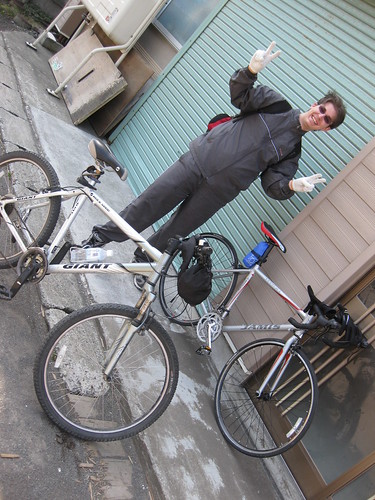
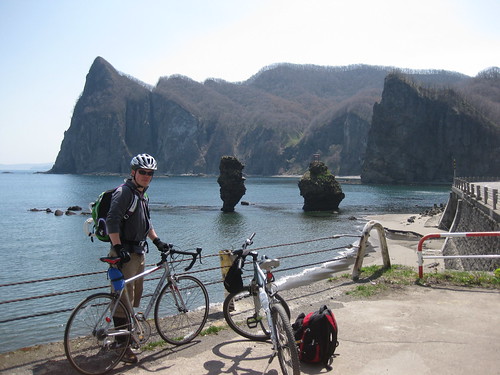 Despite the burn, there is still snow on Teine, and Heather's friends from the UK proved that Niseko was still skiable on that same day that we were biking and getting sunburnt.
Despite the burn, there is still snow on Teine, and Heather's friends from the UK proved that Niseko was still skiable on that same day that we were biking and getting sunburnt.
The following day was spent biking around Sapporo for the first time with Heather, talking in the mad people in Maruyama park who were drinking and barbequing to celebrate the as-of-yet non-existant sakura (cherry blossoms).
This girl was my hero.
Also, there was spontaneous madness afoot.







